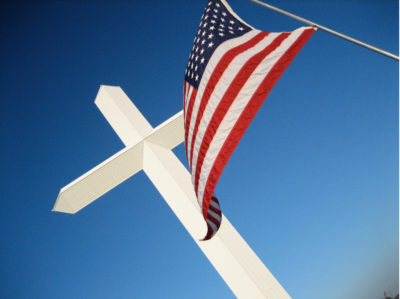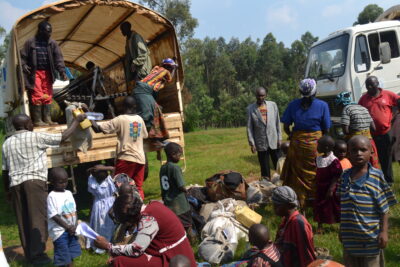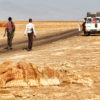In this paper, I focus on the process of evacuation and how, in the case of Hurricane Katrina, this casts light on the position of older people in contemporary western society.
All the evidence I draw on I have gleaned from the Internet. I have not interviewed anyone by phone or email. Most of the material I have collected are newspaper and media reports, but increasingly there is a body of official documentation reviewing what went wrong and how similar disasters might be avoided. In order to keep this unfunded study manageable I have limited it to text and not included visual images of the disaster.
I have organised the paper around four aims:
- to briefly summarise the impact of Katrina on New Orleans
- to consider the significance of age in how people respond to mass evacuations
- to describe how the evacuation of older people from New Orleans was managed
- to reflect on the wider significance of the disaster.
The impact of Katrina
Hurricane Katrina hit New Orleans early in the morning of Monday 29th August 2005. The population of the city was around half a million and most of those affected were residents of the city, living in their own homes. Some however were in institutions at the time: the prison, hospitals and nursing homes.
According to statistics from the 2000 US census, the population of New Orleans was 485,000, of whom 7,400 were aged 85 or more. A total of 17,600 were living in non-households, of whom 2,500 were older people resident in nursing homes. There were about 1,800 hospital beds. These statistics imply that the majority, probably the large majority, of the 7,400 people aged 85 or more were living in ordinary, non-institutional, households.
Table 1 summarises the sequence of key events marking the arrival of Katrina and the evacuation of the city. The Hurricane was formed on Tuesday, the 23rd, and two days later it arrived in Florida. Prior to its arrival, people in Louisiana were faced with two scenarios: leaving or staying put. Some had no means of escaping: 38,000 households had no car. Others could have escaped but chose not to, but most fled over the course of the weekend.


At 5.00 pm on Saturday, the 27th, the Mayor of New Orleans called for a voluntary evacuation of the city and this was made mandatory the following morning at 9.30 am. At midday, recognising that many were unable to leave, he designated the Superdome and a number of other locations as ‘refuges of last resort’.
It has been estimated that by the time Katrina arrived on Monday morning, 85% of the population of New Orleans had escaped, primarily in vehicles. Of the remaining 70,000, 25,000 took refuge in the Superdome. Later that day the first levee was breached and this led to large parts of the city centre being flooded. On Tuesday, following global exposure on television, the evacuation of the Superdome and other refuges was ordered, and this was completed five days later, the following Sunday.
The television images from the Superdome and elsewhere were predominantly of hungry, distressed and angry African-Americans and the connection with race and poverty was made explicit in many of the accompanying commentaries. The BBC for example, ran a story on 4th of September which read:
Images from the stricken city of New Orleans show that many of those suffering in its streets and shelters are black and poor. The plight of those stranded amid the filth and the dead has highlighted a side of the city most tourists do not see – one in which two-thirds of its residents are black and more than a quarter live in poverty.
These images have set the agenda for subsequent debates, both in the media and in the social sciences. There has been much critical comment about the failure of the federal government, and in particular FEMA, the Federal Emergency Management Agency, to respond quickly and effectively. The critique has focused upon the impact of the hurricane on the city as a whole, and the plight of those in the Superdome in particular. In this way the population that suffered has been portrayed as poor and black.
The classic measure of disasters is mortality. How many people died as a result of Katrina, and who were they?
At the present time (August 2006), it has been estimated that Katrina was responsible for the deaths of 1,836 people. There is an interesting debate underway on marginal cases – people who were killed in road accidents while escaping, or who subsequently have committed suicide, for example. Also 141 people are still registered as missing. Authoritative statistics are unavailable.
A provisional analysis undertaken for Knight Ridder newspapers late last year concluded that, if anything, death rates were higher among whites than among African-Americans, and that there were few significant differences in death rates between poor and wealthy neighbourhoods. These figures questioned the popular image of Katrina’s victims as poor and black.
What the analysis also reported was that nearly half the deaths were of people aged 75 or more. Table 2 is based on details of 729 victims whose bodies were taken to one of the two main morgues (I accessed this list on 21 December). It shows that 50% were in their 70s or 80s. The oldest victim was a woman aged 102. Only 39 people under 40 years of age died, less than 6% of all victims listed.
So the disaster primarily affected older people. As John Mutter, of Columbia University, has commented: “When it comes to deaths, this was an age-selective disaster far more than it was race-selective”. Insofar as mortality is an appropriate indicator of disaster, then Katrina was unprecedented because of a failure to protect or evacuate older people effectively.


The relevance of age
How relevant then is age in how people respond to the prospect of disaster and, in particular, to calls to evacuate? There are three distinct ways in which age may be seen as relevant.
- The first is that age is statistically associated with illness and mobility problems. Note that this is not referring solely to people over a certain age. Throughout adulthood, older people are statistically more likely than younger people to have difficulty in moving quickly. They are more likely to be ill or incapacitated.In addition, older people may be less inclined than younger people to escape, because they perceive the risks involved in undertaking long and stressful journeys to be greater. In the case of Katrina, heat, dehydration and the need for medication were all mentioned as disincentives for older people. Older people were less willing than younger people to risk getting caught up in the heat and frustrations of gridlock.Thus, both objectively and subjectively, age counts in this statistical sense, and this makes evacuation more problematic for all concerned.
- Secondly, age is also relevant because of experience and biography.People who have lived in a particular area a long time are familiar with the annual cycle of weather. People have to learn to cope. Those who can cope take each year as it comes. People who can’t cope, tend to leave. So it would follow that the inclination of long-time residents of New Orleans would be to stay put. As one put it, “I grew up with hurricanes. I’m used to them”.Conversely, it is plausible that older people are more attached to their homes and neighbourhoods and less able than younger people to transport their valued possessions to safe places. They may feel more threatened with the loss of their home and by the possibility of being robbed. Who will look after their pets? One newspaper report focused on two 83-year-old twin sisters who insisted on remaining in New Orleans to care for their pets: a dog, cat and bird. Older people may be more inclined than younger people to think of evacuation as abandoning their friends, their home and indeed their city. Arguably the prospect is much more disruptive biographically.
- Thirdly there are policies and attitudes to age and, in particular, ‘the elderly’ and their ‘special needs’. In many areas of life, ageism has the effect of setting ‘the elderly’ apart, stereotyping them by assuming that they require specialised attention to meet their ‘special needs’. Although on occasions they may benefit from being earmarked in this way, there may be the reverse effect: being denied the benefits of more ordinary services and opportunities, and separating them from younger people. According to the Louisiana Emergency Operations Plan, for example, ‘specialized shelters should be established for people with special medical needs’. But, when residents enquired on the Saturday before Katrina where these shelters were, they discovered that there were two in the state, both over 200 miles from New Orleans.
At times of desperation, ‘the elderly’ can suddenly be seen as unmanageable ‘burdens’ for the authorities. Consider the following dramatic claim published in the New York Times:
Yet the breadth of the collapse of one of society’s most basic covenants – to care for the helpless – suggests that the elderly and critically ill plummeted to the bottom of priority lists as calamity engulfed New Orleans.
Setting aside the rhetoric, the claim here is that ‘society’ had failed as a result of bureaucratic practices relating to ‘the elderly’ and their ’needs’.
The evacuation of older people from New Orleans
How then was the evacuation of older people from New Orleans managed?
To date, there is little systematic information. Most of what I have obtained through the internet originates in eye-witness accounts produced, or collected, by journalists. As always of course newspapers have an eye for the ‘good story’ and age often features in these. Older people tend to be portrayed as victims rather than heroes.
These are the four settings from which older people had to be evacuated: from their own homes, from nursing homes, from hospitals and from other institutions.
I have limited evidence about evacuation from other institutions. The prime example, one that has recently been featured on British television, is the prison: the New Orleans Parish Prison. It was also investigated by Human Rights Watch in September last year. There would have been 7,500 to 8,000 inmates in the prison when Katrina struck. As it began to flood, it was abandoned by the guards. There were several reports of dead bodies being seen but, to date, no deaths have been officially reported. One month after Katrina struck, the Department of Corrections spokesperson reported that 517 inmates were still missing. The television film revealed a more phlegmatic and stoical response to the crisis from the older inmates.
Turning to the experience of older people living in their own home, there is little evidence, even anecdotal, of how they responded or of the sequence of decisions they may have faced in seeking refuge. All the internet offers are glimpses of how some people responded and coped.
Many older people will have escaped in advance of the arrival of Katrina. In the preceding week they will have travelled to stay with family in other parts of the USA. Others may have fled, perhaps with their family, over the previous weekend. Even though they were able to leave New Orleans behind, they may have found it a testing experience.
The restaurant critic of the New Orleans daily newspaper, for example, described how a well known restauranteur had set out with his wife, two children and 91-year-old mother-in-law to stay with his sister in Florida. The highway east was closed so they headed to his brother’s farm in Alabama. That proved impossible so they landed on fellow restauranteurs in Jackson, Mississippi. There was no power there however, so they moved on to Oxford, Mississippi, joining other evacuees from what was described as ‘New Orleans’ professional class’.
Others had probably resolved to stay in their own home but, when the floodwaters began to rise, they either evacuated ‘upwards’ perhaps to be rescued from their roof, or they set out from their homes in search of safety:
As a blazing sun and stifling humidity took their toll, 65-year-old Faye Taplin rested alone on the steps of the Christ Cathedral … Rising water had finally chased her from her Central City home. She clutched two plastic bags containing bedding, a little food and water and insulin to treat her diabetes.
There is some evidence that some older people were rescued by people passing by. One report describes how a truck had driven a couple in their 90s from eastern New Orleans and dropped them off outside a convention centre, one of the refuges of last resort. The husband however was already dead and his wife was sitting munching crackers, seemingly unaware of the tragic drama around her.
Other older people sought rescue alongside their neighbours. A newspaper reporter writing on the day Katrina hit New Orleans described how he had heard of a house where a dozen people including ‘some elderly people and a pregnant woman’ were desperate for help.
There is some limited evidence of how older people were denied places on buses. One man told a reporter that he had tried to get his parents on to a bus. His father was 78 and blind, and his mother 75 and crippled with arthritis
I couldn’t get them on because the young people, the healthy people were pushing and fighting to get on the bus. I couldn’t put them in that situation.
This happened repeatedly as buses appeared, filled up, and left. And then, when a bus arrived that was designated for ‘the elderly and disabled’, he and his 62-year-old aunt were not allowed on to accompany his parents.
Many older people were bussed to the Superdome. A geriatrician working there speculated that those who had made it were ‘tough’. She suspected that many of the dead bodies would be “frail elderly who couldn’t sit in the sun for 48 hours”. The implication of this comment is that some will indeed have spent two days in the open air waiting to be rescued.
She described how many were in a confused state as they stepped off the buses. Some needed help to get to food or to a toilet. Some couldn’t hear the loudspeaker announcements. Another evacuee, she said, “shepherded” older people to one area in the Superdome “so they could be together” and so social workers could check their needs.
In contrast to evidence about how people were evacuated from their own homes, we are learning much about the plight of people who were in institutions when Katrina arrived. Legal action is being taken and, in that context, detailed if conflicting accounts are being reported.
Evacuation of nursing homes
The following are the key points about the evacuation of nursing homes in New Orleans.
- Under-resourced homes
- Unclear responsibilities
- Inadequate plans
- Insufficient transport
- Unprepared refuges
- Unexpected crises when forced to relocate
For several years the nursing home industry in Louisiana has been under attack. Recently, for example, the state was sued by nursing-home residents and potential residents who said they could live in their own homes with help. They claimed the state, by not providing community-based services, was unconstitutionally forcing them into nursing homes. This should be borne in mind in reflecting upon how these homes were evacuated.
Of all the 51 states in the USA, Louisiana has the highest rate of beds per 1,000 persons aged 85 or more – 550 per 1,000 – and a lower than average occupancy rate. Some homes in New Orleans were only half full. Indicators of inequality place Louisiana high in the rankings and so there will be nursing homes serving wealthy people that are well-resourced and well able to cope with crises. Several, for example, hired helicopters to evacuate their residents. Others however will have targeted the less wealthy market and it is likely that some of these homes will have been under-resourced and ill-prepared to deal with unexpected floods.
Although all nursing homes in Louisiana were required to have evacuation plans, it was unclear how these were supposed to relate to mandatory evacuation orders such as that issued by the Mayor. This touched on the delicate questions of timing, costs and responsibilities. Had the Mayor insisted on all nursing homes being evacuated then the costs to the authority could have been immense.
Out of 60 nursing homes in New Orleans, 21 had evacuated their residents in advance of Katrina. In fact, the first hurricane-related deaths occurred the day before Katrina struck when three residents died whilst being evacuated to Baton Rouge.
In contrast, over half the nursing homes in New Orleans decided against early evacuation. It was widely felt that many residents would not survive evacuation, and so no preparations were made. One, for example, unlike many others, had a back-up generator on its roof and plans for emergency power if needed. After two days however, it was clear that “things weren’t going to get better soon”, and it was decided to evacuate. In a similar way, all but three homes were ‘forced to relocate’ in the early aftermath of the storm.
A critical aspect of evacuation plans is transport and refuge. Too many homes, it was said, were contracted with the same bus companies. Homes had to wait, and then, when residents were bussed out, it was often to locations that were no better, if not worse, and, as with the Superdome, secondary evacuation became necessary.
One account, for example, describes how a party of people “in their 70s, 80s and 90s” had been found in a “school turned cesspool”. They had been taken there and abandoned. They had medicines and oxygen and this suggests they had been bussed there from a nursing home. According to those who found them, most were unable to move without help. They were there for two nights before being rescued. This evidence suggests that buses being used to empty nursing homes rather than to provide a safe evacuation.
Allegedly, some residents were abandoned by owners and staff. The plight of residents in St. Rita’s home, for example, created an early public outcry. Of 60 residents, 34 were found dead in the home. Neighbours described how they had rescued some of the residents by floating them away on mattresses. A report in the New York Times described how bodies were still in the home a week later; “draped over a wheelchair, wrapped in a shower curtain, lying on a floor in several inches of muck”. The owner of St. Rita’s has since been charged with negligent homicide. He claimed that “most of the families had decided to keep their relatives there”. One wonders at what point these decisions were taken and conveyed to the owner.
What this suggests is that most nursing homes had wholly inadequate plans for evacuation. One comment was that their state-mandated plans “fell spectacularly apart”.
Evacuation of hospitals
The hospitals were explicitly exempt from the Mayor’s mandatory evacuation order. A spokesman said “Hospitals don’t evacuate. Hospitals stay in place.” Rather they were required to have enough emergency provisions to operate for two to three days during a disaster.
Many people, however, were outside seeking refuge and they saw hospitals as tall, solid buildings. And some of these people had friends or relatives currently receiving treatment. Initially people were allowed in. As a result, there were claims that 2,000 people became trapped in the Memorial Medical Centre, a 339-bedded hospital. However, it lost power when its back-up generators failed. The elevators and the air conditioning stopped working. One local resident who had escaped there told a reporter of the “heroic” efforts of nurses to keep patients cool by wafting them with cardboard for hours.
Currently, legal action is underway concerning events on the seventh floor of the hospital. This was leased to a private company that provides long-term patient care. Escape was only possible at the first floor level, six floors below, where boats were transporting patients to helicopters. On the first floor however, the odour was ‘horrendous’ as a result of the stifling heat and the backed-up sewers. Moreover helicopters were scarce and the Federal Emergency Management Agency was intervening. According to the New York Times:
When private companies dispatched helicopters, trucks and buses to evacuate hospitals and nursing homes, officials from FEMA commandeered some of them for other uses … The rescue of those who had remained in their homes, or were sheltered in an increasingly chaotic Superdome, became a priority.
On Wednesday evening, police officers arrived at the hospital to evacuate all non-essential staff. As a result, some patients became separated from members of their families who had come to be with them. The following day, a decision was taken to abandon the hospital and to evacuate all living patients. Only the dead remained.
The doctors and nurses were faced with few options. Conditions were deteriorating rapidly, evacuations were sporadic and security was compromised. Staff agonized whether to attempt to transport critically ill patients who might not survive the arduous evacuation. It appears another choice was considered: whether to end the lives of those who could not be moved.
The actions of one doctor and two nurses have become another on-going legal case. Allegedly they had been engaged in acts of euthanasia. Thus the policy that hospitals should not evacuate but should be able to cope with emergencies had failed and staff were placed in an iniquitous position. There were no plans for a ‘no alternative but to escape’ scenario.
In summary there are six key issues in the on-going debates and legal actions associated with nursing homes and hospitals:
- the existence and status of evacuation plans
- deciding whether and when to evacuate
- the availability of transport
- the preparation of refuges
- the responsibilities of staff in managing an evacuation
- the practice of euthanasia.
Lessons to be learnt
It is too early to draw any firm conclusions from Katrina. The available evidence however casts some light on how age is relevant to the organisation of mass evacuations and the position of older people in western societies. The most obvious point is that the media focus on race and poverty has tended to mask the issue of age.
The significance of the statistical association of physical capacity and age is confirmed. It is clear that on average older people are slower, less resilient and less inclined to escape. This is, and should be, taken into account in the planning of evacuations.
Secondly, past experience and personal biographies are relevant. The real disaster in New Orleans was not the hurricane itself, but the breaching of the levees and the subsequent flooding of large parts of the city. Had the levees not been breached then it is possible that there would have been far fewer deaths. Possibly most of the deaths of older people would have been due to the stress of evacuation, rather than the trials of sitting out the hurricane. The mistake of many was to think that Katrina was ‘just another hurricane’.
Finally, the concept of ‘special needs’ is a double-edged sword. Several commentators noted that the highest rates of Katrina-related deaths were among hospital patients and the residents of nursing homes.
Some might react to this by arguing that the elderly and critically ill were at the end of their lives and, when faced with such a calamitous situation, the young should come first. But as one grandson commented: “My grandmother wasn’t supposed to die like this”.
A paper presented at the annual conference of the Royal Geographical Society and Institute of British Geographers, London, 31 August 2006.













